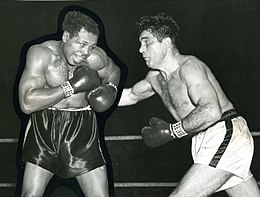Archie Moore
Unable to provide for him and his older sister, his mother gave them into the care of an uncle and aunt, Cleveland and Willie Pearl Moore, who lived in St. Louis.
After he was arrested for attempting to steal change from a motorman's box on a streetcar, he was sentenced to a three-year term at a reform school in Booneville, Missouri.
Around 1933 Moore joined the Civilian Conservation Corps, working for the forestry division at a camp in Poplar Bluff, Missouri.
He later recalled that the other boys constantly kidded him about one daily exercise—standing upright in the bed of a truck as it drove along primitive forest roads, waiting until the last possible moment before ducking or weaving away from tree branches.
The captain of the camp permitted him to organize a boxing team, which competed in Golden Gloves tournaments in southern Missouri and Illinois.
Many of his fights occurred in a racially charged atmosphere; he later described one of them, against a white boxer named Bill Richardson in Poplar Bluff:I knocked him down with a volley of head punches about one minute into round one.
He won his first six bouts that year, including a second-round knockout of Hogue in a rematch, and a ten-round decision over Jack Chase.
He won his first eight bouts of 1945, impressing Atlantic coast boxing experts and earning a fight with light heavyweight Jimmy Bivins, a boxer that was not considered a hard puncher, who defeated Moore by a knockout in six at Cleveland.
He met, among others, light heavyweight Holman Williams during that span, losing a ten-round decision, and knocking him out in eleven in the rematch.
On June 2, 1948, Leonard Morrow (12–2–1) KO’d Archie Moore (92–14–7) in the first round to win the California light heavyweight championship.
Against Maxim, Moore consistently landed powerful right hands, hurting him several times en route to a fifteen-round decision.
The next year, Moore won all nine of his bouts, including a 10-round, non-title win against then fringe heavyweight contender Nino Valdez of Cuba and a 15-round decision over Maxim in a rematch to retain the belt.
1 heavyweight contender, and defended against Bobo Olson, the World Middleweight Champion and future Hall of Famer who was coming off a decision victory over Joey Maxim, by a knockout in three.
A Moore surprise right hand in the 2nd round sent Marciano down for the second and final time in his career, setting the stage for a legendary battle, but also creating controversy as far as shared memory.
By the time of a recorded interview with Peter Heller, in October, 1970, Archie had this to say: "(Kessler) had no business refereeing that match because he was too excitable.
In his own autobiography, Harry Kessler indeed recounts Marciano-Moore with a great excitement, frequently employing exclamation marks in his punctuation, going so far as a direct comparison to the donnybrook between Jack Dempsey and Luis Firpo.
As for the knockdown, described here also in detail, Kessler offers a perspective directly contradicting Moore's, saying "I didn't bother to wipe Marciano's gloves on my shirt before I waved them back to combat; that early in the drama, there was no resin on the canvas."
With humor and without malice, Kessler even recounts the 41-year-old Moore poo-pooing any talk of retirement at the postfight press conference, then sitting in on bass fiddle at a hotspot in Greenwich Village until 5 a.m.!
], but continued to be recognized by most major boxing authorities including the New York State Athletic Commission and The Ring Magazine.
In 1962, the remaining boxing commissions that had continued to back Moore as the World Light Heavyweight Champion withdrew their recognition[why?].
By the time the bout took place, the California commission, like New York, Massachusetts, the EBU and Ring Magazine, had recognized Harold Johnson, who had beaten Doug Jones 16 days earlier, as the new Light Heavyweight Champion.
Then, in his last fight of note, the 49 year-old Moore faced a young heavyweight out of Louisville named Cassius Clay (Muhammad Ali).
After one more fight in 1963, a third-round knockout win over Mike DiBiase in Phoenix, Moore announced his retirement from boxing, for good.
He is one of only a handful of boxers whose careers spanned four decades, retiring with a final record of 185 wins, 23 losses, 11 draws and 1 no contest, with 131 official knockouts.
In 1974 he helped train heavyweight boxer George Foreman for his famous "Rumble in the Jungle" title bout in Zaire against Muhammad Ali.
Actively involved in efforts to teach children about the dangers of drug abuse, he worked during the 1980s as a youth boxing instructor for the federal Department of Housing and Urban Development, assigned largely to ghettos in San Diego and Los Angeles.
[10] In 1960, Moore was chosen to play the role of the runaway slave Jim in Michael Curtiz's The Adventures of Huckleberry Finn, based on the Mark Twain novel, opposite Eddie Hodges as Huck.
Moore garnered positive reviews for his sympathetic portrayal of Jim, which some viewers still consider the best interpretation of this much-filmed role.
[citation needed] Moore did not choose to pursue a full-time career as an actor, but he did appear in films such as The Carpetbaggers (1964), The Hanged Man (1964) and The Fortune Cookie (1966), and on television in episodes of Family Affair, Perry Mason, Wagon Train, The Reporter, Batman (episode 35) and the soap opera One Life to Live.
Moore's victory made headlines and caught the attention of the Argentinian President Juan Perón and his wife Eva for his selfless act helping children, buying them shoes, clothing, and building their confidence.




